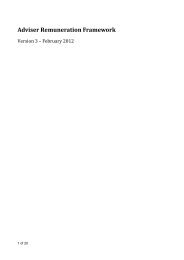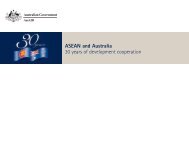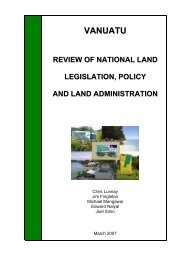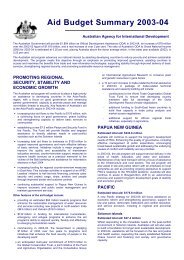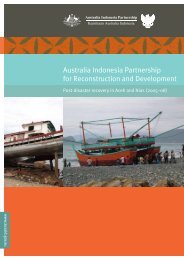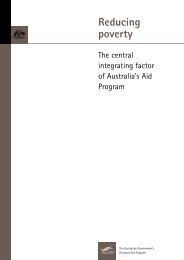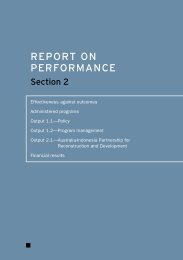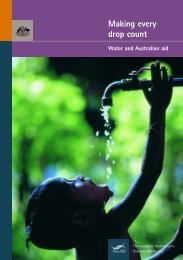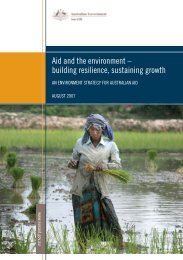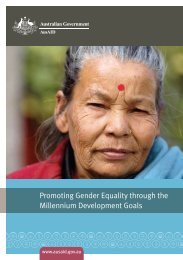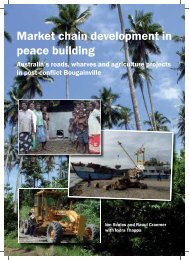Australian Aid to PNG - AusAID
Australian Aid to PNG - AusAID
Australian Aid to PNG - AusAID
Create successful ePaper yourself
Turn your PDF publications into a flip-book with our unique Google optimized e-Paper software.
Although the precise extent of the dutch disease problem is somewhat unclear, asense of the potential impact is provided by the large fall in the nominal value of thekina in recent years. Since the kina was floated in Oc<strong>to</strong>ber 1994, it has been on adownward trend attributable <strong>to</strong> declining mining and oil revenue, the gradual removalof <strong>Australian</strong> budget support and large Government budget deficits. At the time ofthe float, the kina was roughly at parity with the US$. Such a high exchange rate hasproven unsustainable and the kina is now worth around a quarter of its pre-floatvalue in US$ terms. 4It is important <strong>to</strong> appreciate that the dutch disease problem in Papua New Guinea couldhave been largely avoided. The original intention of the Government was that revenuefrom the mining and oil sec<strong>to</strong>r was <strong>to</strong> be saved in the Mineral Resource StabilisationFund (the MRSF). While positive account balances were recorded over the 1990s, these‘savings’ were only book entries and budget deficits meant that the Governmentactually quickly spent the mining and oil revenue. If instead the mining and oil revenuehad been saved and spent gradually as originally intended, the effect on the exchangerate and hence non-mining and oil sec<strong>to</strong>rs would have been much less.So in one sense the dutch disease problem evident in Papua New Guinea is best seenas a result of how the Government used the mining and oil revenue, rather thanmining and oil activity per se. The large inflow of aid has also been an importantcontribu<strong>to</strong>r <strong>to</strong> the problem. It follows that the dutch disease problem is best though<strong>to</strong>f as a result of the public sec<strong>to</strong>r rather than the mining and oil projects alone.As a result of a decline in mining and oil revenue and the removal of <strong>Australian</strong>budget support, the economy is now facing the effects of an unwinding of a ‘dutchdisease’ problem that has seen the public sec<strong>to</strong>r undermine prospects for the privatesec<strong>to</strong>r for much of the period since independence. 5 This is triggering economicchanges that are creating problems for many in the community, notably in the urbancentres reliant on formal economic activity. This is frequently described as a crisis,and is seen by some as evidence of a failing state. But the changes are also creatingopportunities for others, notably for the rural poor and the informal sec<strong>to</strong>r. Over time,the changes triggered by a falling kina can be expected <strong>to</strong> see a sustainable economyemerge providing for improved growth and poverty outcomes. While the adjustmentnow occurring could certainly be managed at a lower cost (if for example theGovernment controlled overspending and provided well maintained physicalinfrastructure), it offers important benefits for the long term.4 It is emphasised that the fall in the nominal value of the kina is also in part a result of over-expenditure bythe National Government. Had the National Government operated balanced budgets and not the large deficitsseen over the last ten years, the nominal value of the kina would be considerably higher than at present(see Sugden (2002) for a discussion).5 See Sugden (2000).The Contribution of <strong>Australian</strong> <strong>Aid</strong> <strong>to</strong> Papua New Guinea’s Development 1975–2000 23



